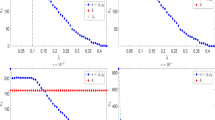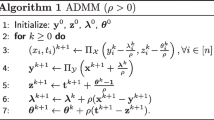Abstract
We discuss the L p (0 ≤ p < 1) minimization problem arising from sparse solution construction and compressed sensing. For any fixed 0 < p < 1, we prove that finding the global minimal value of the problem is strongly NP-Hard, but computing a local minimizer of the problem can be done in polynomial time. We also develop an interior-point potential reduction algorithm with a provable complexity bound and demonstrate preliminary computational results of effectiveness of the algorithm.
Similar content being viewed by others
References
Berinde, R., Gilbert, A.C., Indyk, P., Karloff, H.J., Strauss, M.J.: Combining geometry and combinatorics: a unified approach to sparse signal recovery, preprint (2008)
Bertsekas D.P.: Nonlinear Programming. Athena Scientific, Belmont (1999)
Bertsimas D., Tsitsiklis J.: Introduction to Linear Optimization, pp. 414. Athena Scientific, Belmont (1997)
Blumensath T., Davies M.: Iterative hard thresholding for compressed sensing. Appl. Comp. Harmonic Anal. 27, 265–274 (2009)
Borwein, J.M., Luke, D.R.: Entropic Regularization of the ł0 function, In: Fixed-point algorithms for Inverse Problems in Science and Engineering in Springer optimization and its Applications (2010)
Bruckstein A.M., Donoho D.L., Elad M.: From sparse solutions of systems of equations to sparse modeling of signals and images. SIAM Rev. 51(1), 34C81 (2009)
Candès E.J., Tao T.: Decoding by linear programming. IEEE Trans. Inf. Theory 51, 4203–4215 (2005)
Candès E.J., Tao T.: Near optimal signal recovery from random projections: Universal encoding strategies. IEEE Trans. Inf. Theory 52, 5406–5425 (2006)
Chartrand, R.: Exact reconstruction of sparse signals via nonconvex minimization. IEEE Signal Process. Lett. 14–10 (2009)
Chartrand, R.: Fast algorithms for nonconvex compressive sensing: MRI reconstruction from very few data, In: IEEE International Symposium on Biomedical Imaging (ISBI) (2009)
Chen,X., Xu, F., Ye, Y.: Lower bound theory of nonzero entries in solutions of ℓ 2-ℓ p minimization, Technical Report, The Hong Kong, Polytechnic University (2009)
Donoho, D.: For most large underdetermined systems of linear equations the minimal l 1-norm solution is also the sparsest Solution, Technical Report, Stanford University (2004)
Fan J., Li R.: Variable selection via nonconcave penalized likelihood and its oracle properties. J. Am. Stat. Soc. 96, 1348–1360 (2001)
Gilbert, A.C., Muthukrishnan, M., Strauss, M.J.: Approximation of functions over redundant dictionaries using coherence, In: Proceedings of the Fourteenth Annual ACM-SIAM Symposium on Discrete Algorithms (SODA) (2003)
Garey M.R., Johnson D.S.: Strong NP-Completeness: results, motivation examples and implications. J. Assoc. Comput. Mach. 25, 499–508 (1978)
Garey M.R., Johnson D.S.: Computers and Intractability A Guide to the Theory of NP-Completeness, pp. 96–105. W. H. Freeman, San Francisco (1979)
Mourad N., Reilly P.: Minimizing nonconvex functions for sparse vector reconstruction. IEEE Trans. Signal Process. 58, 3485–3496 (2010)
Nesterov Y., Nemirovski A.: Interior Point Polynomial Methods in Convex Programming. SIAM, Philadelphia, PA (1994)
Natarajan B.K.: Sparse approximate solutions to linear systems. SIAM J. Comput. 24, 227–234 (1995)
Terlaky T.: On ℓ p programming. Eur. J. Oper. Res. 22, 70–100 (1985)
Tropp J.A.: Greed is good: algorithmic results for sparse approximation. IEEE Trans. Info. Theory 50, 2231–2242 (2004)
Tropp, J., Wright, S.J.: Computational methods for sparse solutions of linear inverse problems. In: Proceedings of the IEEE (2010)
Vavasis S.A.: Polynomial time weak approximation algorithms for quadratic programming. In: Floudas, C.A., Pardalos, P.M. (eds) Complexity in Numerical Optimization, World Scientific, New Jersey (1993)
Vazirani V.: Approximation Algorithms. Springer, Berlin (2003)
Xue G., Ye Y.: An efficient algorithm for minimizing a sum of P-norms. SIAM J. Optim. 10, 551–579 (2000)
Ye Y.: On the complexity of approximating a KKT point of quadratic programming. Math. Progr. 80, 195–211 (1998)
Ye Y.: Interior Point Algorithms: Theory and Analysis. Wiley, New York (1997)
Author information
Authors and Affiliations
Corresponding author
Rights and permissions
About this article
Cite this article
Ge, D., Jiang, X. & Ye, Y. A note on the complexity of L p minimization. Math. Program. 129, 285–299 (2011). https://doi.org/10.1007/s10107-011-0470-2
Received:
Accepted:
Published:
Issue Date:
DOI: https://doi.org/10.1007/s10107-011-0470-2




